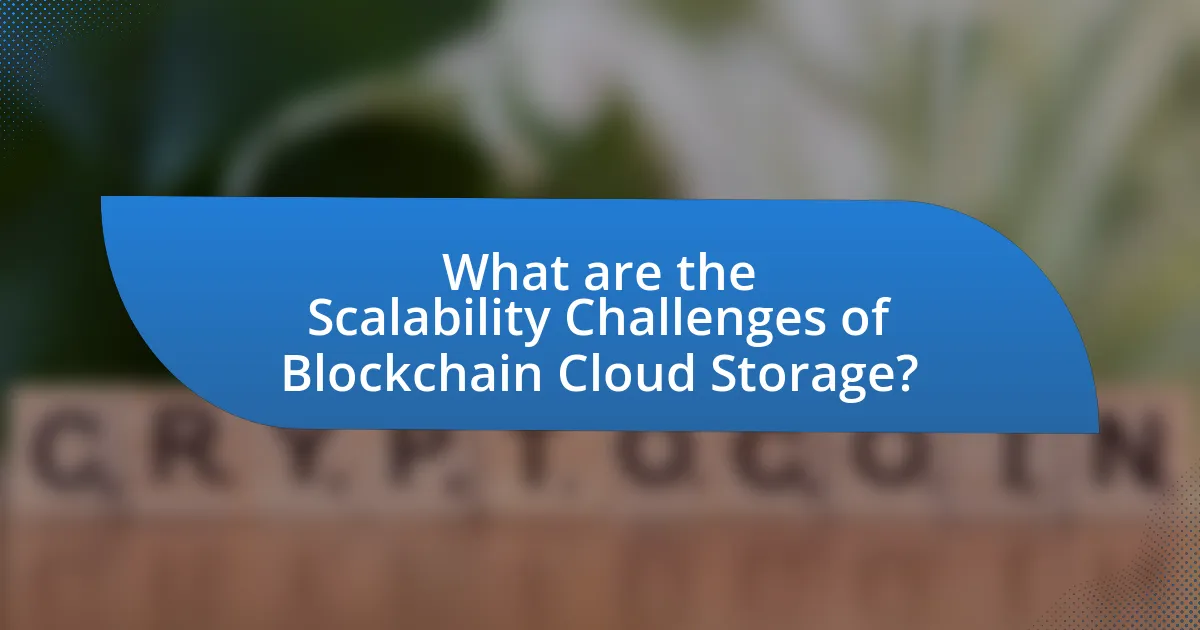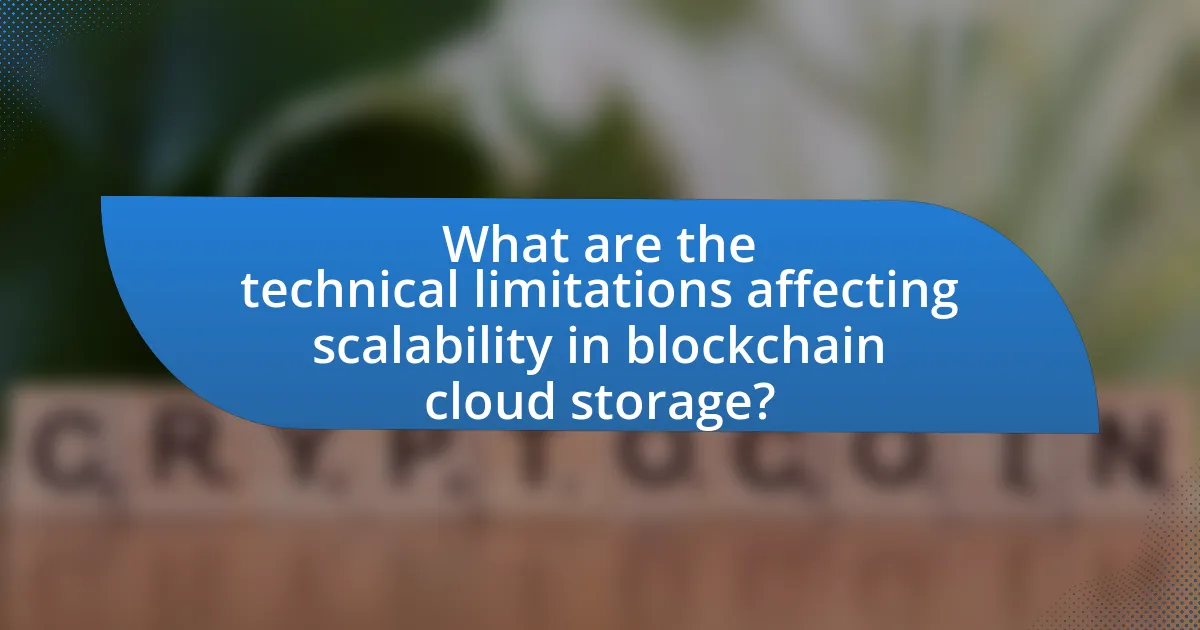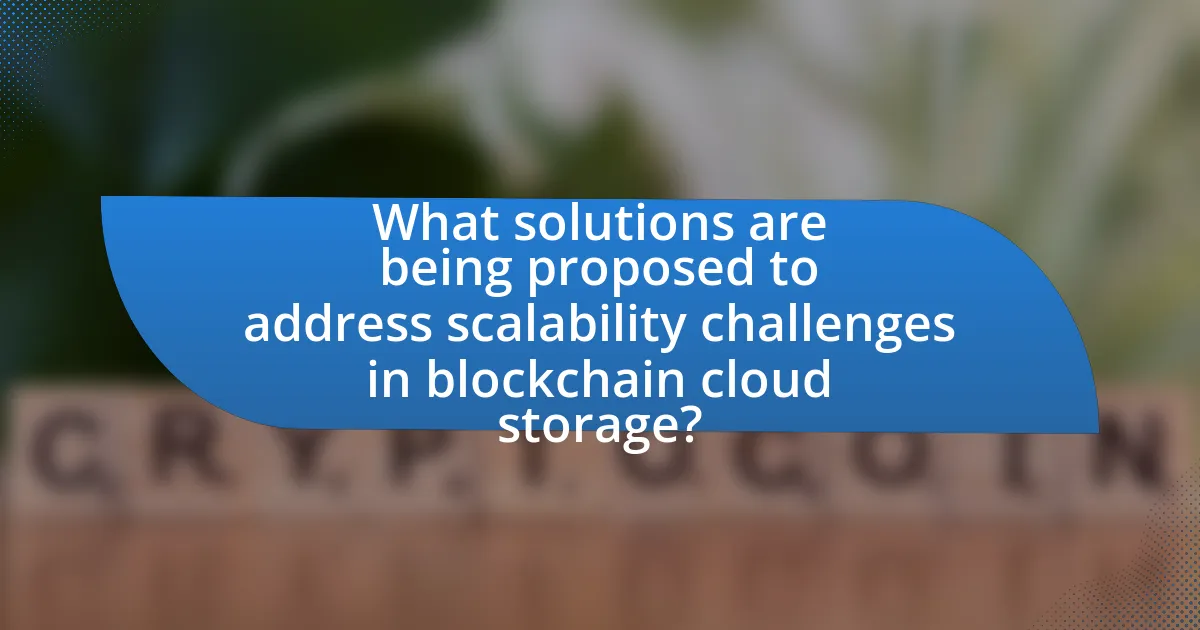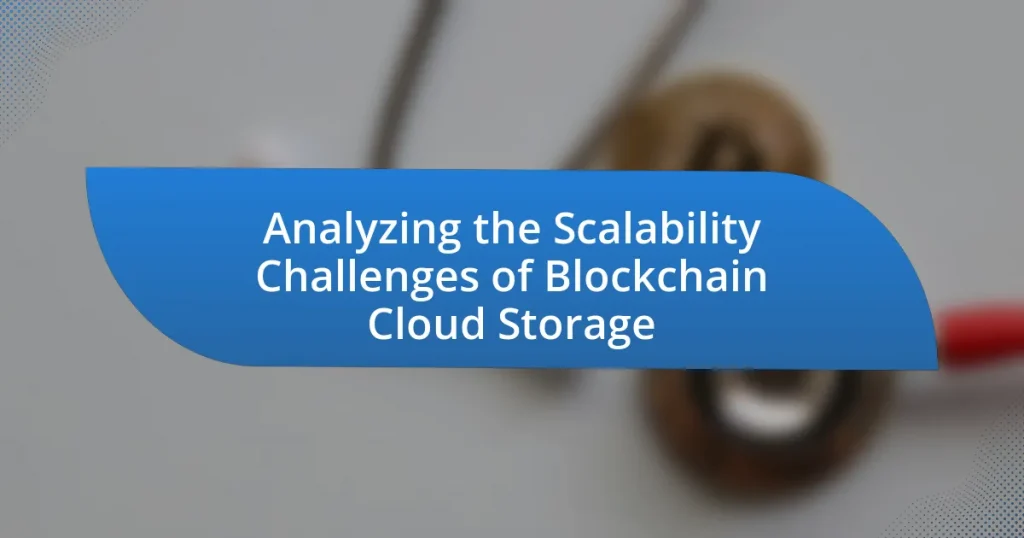The article analyzes the scalability challenges of blockchain cloud storage, focusing on issues such as limited transaction throughput, high latency, and storage inefficiencies. It highlights how these challenges impact performance, user experience, and the overall adoption of blockchain technology. Key topics include the role of consensus mechanisms, the effects of data size and transaction volume, and proposed solutions like sharding and layer-2 protocols. The discussion emphasizes the importance of scalability for enhancing efficiency and competitiveness in cloud storage solutions, while also addressing technical limitations and best practices for organizations seeking to optimize their blockchain systems.

What are the Scalability Challenges of Blockchain Cloud Storage?
The scalability challenges of blockchain cloud storage primarily include limited transaction throughput, high latency, and storage inefficiencies. Limited transaction throughput arises because most blockchain networks can only process a finite number of transactions per second, which can hinder performance as user demand increases. High latency occurs due to the time required for consensus mechanisms to validate transactions, leading to delays in data retrieval and storage. Storage inefficiencies stem from the need to replicate data across multiple nodes, which can result in excessive resource consumption and increased costs. These challenges are evidenced by studies indicating that popular blockchain platforms like Bitcoin and Ethereum face significant scalability issues, with Bitcoin processing approximately 7 transactions per second and Ethereum around 30, far below the capabilities of traditional cloud storage solutions.
How does scalability impact the performance of blockchain cloud storage?
Scalability significantly impacts the performance of blockchain cloud storage by determining the system’s ability to handle increased data loads and user demands without compromising speed or efficiency. As the number of transactions and data stored on the blockchain grows, a scalable architecture ensures that performance remains optimal, allowing for faster data retrieval and processing times. For instance, research indicates that blockchain systems like Ethereum face congestion issues when transaction volumes exceed their capacity, leading to slower transaction times and higher fees. Therefore, effective scalability solutions, such as sharding or layer-2 protocols, are essential for maintaining high performance in blockchain cloud storage environments.
What specific scalability issues are faced by blockchain cloud storage systems?
Blockchain cloud storage systems face specific scalability issues primarily due to limited transaction throughput and data storage constraints. The decentralized nature of blockchain requires consensus mechanisms that can slow down transaction processing speeds, leading to bottlenecks as user demand increases. For instance, Bitcoin’s network can handle approximately 7 transactions per second, while Ethereum processes around 30, which is insufficient for large-scale applications. Additionally, the need to replicate data across multiple nodes increases storage requirements, making it challenging to scale efficiently. These factors contribute to higher latency and increased costs, hindering the overall scalability of blockchain cloud storage solutions.
How do these issues affect user experience and data accessibility?
Scalability challenges in blockchain cloud storage significantly hinder user experience and data accessibility. These issues lead to slower transaction speeds and increased latency, which frustrate users seeking quick access to their data. For instance, a study by the International Journal of Information Management found that as the number of transactions increases, the time taken to confirm transactions can rise dramatically, impacting user satisfaction. Additionally, limited storage capacity can restrict the amount of data users can store, making it difficult for them to utilize the full potential of blockchain technology. This combination of slow performance and restricted access directly diminishes the overall effectiveness of blockchain cloud storage solutions.
Why is scalability crucial for the adoption of blockchain cloud storage?
Scalability is crucial for the adoption of blockchain cloud storage because it determines the system’s ability to handle increasing amounts of data and user transactions efficiently. Without scalability, blockchain cloud storage solutions may experience slow performance, high costs, and limited usability, which can deter users and businesses from adopting the technology. For instance, Ethereum, a leading blockchain platform, has faced scalability issues that resulted in high transaction fees and slower processing times during peak usage, highlighting the need for scalable solutions to support widespread adoption.
What role does scalability play in the overall efficiency of blockchain technology?
Scalability is crucial for the overall efficiency of blockchain technology as it determines the system’s ability to handle an increasing number of transactions without compromising performance. Efficient scalability allows blockchain networks to process more transactions per second, which is essential for widespread adoption and usability in real-world applications. For instance, Bitcoin processes approximately 7 transactions per second, while Ethereum handles around 30, highlighting significant limitations in scalability. In contrast, newer blockchain solutions like Solana can process over 65,000 transactions per second, demonstrating how enhanced scalability directly improves efficiency and user experience. Thus, scalability directly impacts transaction speed, network congestion, and overall system performance, making it a vital factor in the effectiveness of blockchain technology.
How does scalability influence the competitive landscape of cloud storage solutions?
Scalability significantly influences the competitive landscape of cloud storage solutions by determining a provider’s ability to accommodate growing data demands efficiently. Providers that offer scalable solutions can quickly adjust resources to meet customer needs, thereby attracting more clients and retaining existing ones. For instance, according to a report by Gartner, companies that implement scalable cloud storage solutions can reduce operational costs by up to 30% while improving service delivery. This competitive advantage allows scalable providers to outperform those with rigid infrastructures, as they can better handle fluctuations in data volume and user demand.

What are the technical limitations affecting scalability in blockchain cloud storage?
The technical limitations affecting scalability in blockchain cloud storage include network congestion, limited transaction throughput, and data storage inefficiencies. Network congestion arises when the number of transactions exceeds the capacity of the blockchain, leading to slower processing times. Limited transaction throughput is a result of the consensus mechanisms used in blockchain, such as Proof of Work, which can only process a finite number of transactions per second; for instance, Bitcoin can handle approximately 7 transactions per second, while Ethereum processes around 30. Data storage inefficiencies occur because each node in the blockchain must store a complete copy of the entire ledger, which can lead to significant storage requirements and slow down the network as it grows. These factors collectively hinder the ability of blockchain cloud storage systems to scale effectively.
How do consensus mechanisms impact scalability?
Consensus mechanisms significantly impact scalability by determining how quickly and efficiently transactions can be processed and validated within a blockchain network. For instance, Proof of Work, used by Bitcoin, requires extensive computational resources and time to validate transactions, which can lead to slower processing speeds and limited transaction throughput, thus hindering scalability. In contrast, mechanisms like Proof of Stake or Delegated Proof of Stake allow for faster transaction validation by reducing the computational burden, enabling higher transaction volumes and improved scalability. Research indicates that networks utilizing more efficient consensus mechanisms can achieve thousands of transactions per second, compared to the mere seven transactions per second of Bitcoin, illustrating the direct correlation between the choice of consensus mechanism and the scalability of blockchain systems.
What are the most common consensus algorithms used in blockchain cloud storage?
The most common consensus algorithms used in blockchain cloud storage are Proof of Work (PoW), Proof of Stake (PoS), and Delegated Proof of Stake (DPoS). PoW, utilized by Bitcoin, requires computational power to solve complex mathematical problems, ensuring security but often leading to scalability issues due to high energy consumption. PoS, adopted by networks like Ethereum 2.0, allows validators to create new blocks based on the number of coins they hold, improving energy efficiency and transaction speed. DPoS, used by platforms like EOS, involves stakeholders voting for a small number of delegates to validate transactions, enhancing scalability and reducing block confirmation times. These algorithms are critical in addressing the scalability challenges inherent in blockchain cloud storage systems.
How do these algorithms limit or enhance scalability?
Algorithms in blockchain cloud storage enhance scalability by enabling efficient data distribution and retrieval, while also limiting scalability through increased computational requirements and network congestion. For instance, consensus algorithms like Proof of Stake reduce the energy and time needed for transaction validation, thus improving scalability. Conversely, algorithms that require extensive computational power, such as Proof of Work, can slow down transaction processing and limit the number of transactions per second, leading to bottlenecks. Additionally, the use of smart contracts can enhance scalability by automating processes, but complex contracts may introduce latency and increase the load on the network. Therefore, the choice of algorithm directly impacts the scalability of blockchain cloud storage systems.
What are the storage and bandwidth constraints in blockchain systems?
Blockchain systems face significant storage and bandwidth constraints due to their decentralized nature and the need for data redundancy. Each node in a blockchain network must store a complete copy of the blockchain, which can lead to substantial storage requirements as the blockchain grows; for instance, Bitcoin’s blockchain exceeded 400 GB in size by 2021. Additionally, bandwidth constraints arise because every transaction must be propagated across the network, requiring considerable data transfer capacity, especially during peak usage times. This can result in slower transaction speeds and increased costs for users and operators, as seen in Ethereum’s network congestion during high-demand periods, where transaction fees surged significantly.
How do data size and transaction volume affect scalability?
Data size and transaction volume significantly impact scalability by determining the system’s ability to handle increased loads efficiently. Larger data sizes require more storage capacity and processing power, which can lead to slower transaction speeds and increased latency. For instance, blockchain networks like Bitcoin face scalability issues as the size of the blockchain grows, resulting in longer verification times for transactions. Additionally, higher transaction volumes can overwhelm the network, causing congestion and delays. A study by the Cambridge Centre for Alternative Finance indicates that Bitcoin’s transaction throughput is limited to approximately 7 transactions per second, which is insufficient for mass adoption. Thus, both data size and transaction volume are critical factors that directly influence the scalability of blockchain systems.
What strategies can be employed to optimize storage and bandwidth usage?
To optimize storage and bandwidth usage, implementing data deduplication, compression, and efficient data retrieval methods is essential. Data deduplication eliminates redundant copies of data, significantly reducing storage requirements; for instance, studies show that deduplication can save up to 90% of storage space in certain environments. Compression algorithms, such as gzip or LZ4, further minimize the size of data transmitted over networks, enhancing bandwidth efficiency. Additionally, utilizing content delivery networks (CDNs) can improve data retrieval speeds and reduce bandwidth consumption by caching content closer to users. These strategies collectively enhance the performance and scalability of blockchain cloud storage systems.

What solutions are being proposed to address scalability challenges in blockchain cloud storage?
Proposed solutions to address scalability challenges in blockchain cloud storage include sharding, off-chain storage, and layer-2 solutions. Sharding divides the blockchain into smaller, manageable pieces, allowing parallel processing of transactions, which enhances throughput. Off-chain storage utilizes external storage systems to handle large data volumes while maintaining blockchain integrity, thus reducing on-chain load. Layer-2 solutions, such as state channels and sidechains, facilitate faster transactions by processing them off the main blockchain and only settling final states on-chain, significantly improving scalability. These methods have been validated through various implementations, demonstrating their effectiveness in enhancing blockchain performance and capacity.
How can layer 2 solutions improve scalability?
Layer 2 solutions improve scalability by enabling transactions to occur off the main blockchain, thereby reducing congestion and increasing throughput. These solutions, such as state channels and sidechains, allow for a higher volume of transactions to be processed simultaneously without burdening the primary blockchain network. For instance, the Lightning Network for Bitcoin can handle millions of transactions per second, significantly enhancing scalability compared to the base layer’s limitations. This offloading of transactions not only speeds up processing times but also lowers transaction fees, making blockchain systems more efficient and user-friendly.
What are the most effective layer 2 solutions currently available?
The most effective layer 2 solutions currently available include the Lightning Network, Optimistic Rollups, and zk-Rollups. The Lightning Network enables fast and low-cost transactions on Bitcoin by creating off-chain payment channels, significantly enhancing scalability. Optimistic Rollups, utilized by Ethereum, allow for batch processing of transactions off-chain while assuming validity, which increases throughput and reduces congestion. zk-Rollups, also on Ethereum, utilize zero-knowledge proofs to bundle multiple transactions into a single proof, ensuring security and efficiency while minimizing on-chain data. These solutions have been validated through their adoption in various decentralized applications and their ability to reduce transaction fees and increase transaction speeds.
How do these solutions integrate with existing blockchain cloud storage systems?
These solutions integrate with existing blockchain cloud storage systems by utilizing decentralized protocols that enhance data accessibility and security. For instance, many blockchain cloud storage solutions employ smart contracts to automate data transactions, ensuring that data is stored and retrieved efficiently while maintaining integrity. Additionally, interoperability standards such as IPFS (InterPlanetary File System) allow these solutions to seamlessly connect with existing blockchain infrastructures, facilitating the sharing and management of data across different platforms. This integration is supported by the growing adoption of decentralized applications (dApps) that leverage blockchain technology for enhanced scalability and performance, as evidenced by the increasing number of projects utilizing these frameworks to address storage challenges.
What role does sharding play in enhancing scalability?
Sharding enhances scalability by dividing a database into smaller, more manageable pieces called shards, allowing for parallel processing of transactions. This approach reduces the load on individual nodes, enabling the system to handle a higher volume of transactions simultaneously. For instance, in blockchain technology, sharding can significantly increase throughput by allowing different shards to process transactions independently, thereby improving overall network efficiency. Studies have shown that implementing sharding can lead to performance improvements of up to 1000 times compared to traditional blockchain architectures, demonstrating its effectiveness in addressing scalability challenges.
How does sharding work in the context of blockchain cloud storage?
Sharding in blockchain cloud storage involves dividing data into smaller, manageable pieces called shards, which are distributed across multiple nodes. This method enhances scalability by allowing parallel processing and storage, reducing the load on individual nodes and improving overall system performance. For instance, in a blockchain network, each shard can handle transactions independently, leading to increased throughput and faster data retrieval. Research indicates that sharding can significantly improve transaction speeds and reduce latency, making it a viable solution for addressing scalability challenges in blockchain cloud storage systems.
What are the potential drawbacks of implementing sharding?
The potential drawbacks of implementing sharding include increased complexity in system architecture and challenges in data consistency. Sharding divides a database into smaller, more manageable pieces, which can complicate the overall design and require more sophisticated management tools. Additionally, ensuring data consistency across different shards can be difficult, as transactions may need to be coordinated between shards, leading to potential latency issues. Research indicates that these complexities can result in higher operational costs and increased risk of errors during data retrieval and updates.
What best practices can be adopted to improve scalability in blockchain cloud storage?
To improve scalability in blockchain cloud storage, adopting sharding is essential, as it allows the network to process transactions in parallel by dividing the data into smaller, manageable pieces. This method enhances throughput and reduces latency, enabling the system to handle a larger volume of transactions simultaneously. Additionally, implementing off-chain storage solutions can alleviate the burden on the blockchain by storing large files externally while maintaining a reference on-chain, thus optimizing storage efficiency. Furthermore, utilizing layer-2 scaling solutions, such as state channels or sidechains, can significantly increase transaction speeds and reduce costs by processing transactions off the main blockchain. These practices are supported by research indicating that sharding can increase transaction throughput by up to 1000 times compared to traditional blockchain architectures, demonstrating their effectiveness in addressing scalability challenges.
How can organizations effectively assess their scalability needs?
Organizations can effectively assess their scalability needs by conducting a thorough analysis of current system performance metrics and future growth projections. This involves evaluating existing infrastructure capabilities, user demand patterns, and transaction volumes to identify potential bottlenecks. For instance, a study by Gartner indicates that organizations should analyze data throughput and latency to determine if their current systems can handle increased loads. Additionally, organizations can implement load testing and stress testing to simulate high-demand scenarios, which provides concrete insights into how systems will perform under pressure. By combining these analytical methods with predictive modeling, organizations can make informed decisions about necessary upgrades or changes to their scalability strategies.
What are the key considerations for implementing scalable blockchain cloud storage solutions?
Key considerations for implementing scalable blockchain cloud storage solutions include data redundancy, network performance, security protocols, and interoperability. Data redundancy ensures that information is replicated across multiple nodes, enhancing reliability and availability. Network performance is critical, as it affects the speed of data retrieval and storage; solutions must optimize bandwidth and minimize latency. Security protocols must be robust to protect sensitive data from unauthorized access and breaches, often employing encryption and access controls. Interoperability allows different blockchain systems to communicate effectively, facilitating seamless data exchange and integration with existing cloud infrastructures. These considerations are essential for achieving a scalable and efficient blockchain cloud storage solution.


